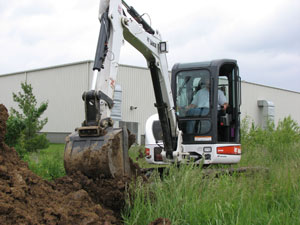October 15, 2010

Withannual energy usage estimated at 1 percent of all energy consumed in the U.S.,off-highway construction equipment consumes more energy each year than all thedehumidifiers, refrigerators, microwaves and TVs combined. From skid steers tobackhoes, the potential for energy savings is putting a new focus on innovativehydraulic solutions.
"Inthe past, hydraulic system optimization focused on controllability, cost andreliability," says Joe Pfaff, vice president of Engineering at INCOVATechnologies. "Today, the fourth dimension in the value proposition is efficiency."In the U.S. and even more so in Europe, India and China, fuel costs and thepercentage of operating cost related to fuel is getting higher. This is drivingOEMs and the entire supply chain to innovate solutions that provide higher fuelefficiency.
Many companies are working to optimizehydraulic efficiency by using variable displacement pumps and load sense systems.But one thing that HUSCO has learnedis that understanding the vehicle duty cycle is critical for designing optimal hydraulicsystems. Pfaff says an enormous amount of work has been done at HUSCO and INCOVAto create a foundation of know-how related to efficiency that is drawn upon to optimizehydraulic systems. If the focus is onvalve operation in a laboratory environment, it will lead to sub-optimalsolutions. It is critically important to understand how the valve works in themachine to provide high value, differentiated products.
"Within the last 18 months, we have donetesting and analysis on over a dozen machines ranging from skid steers, toexcavators (4 tons up to 25 tons) and backhoes. This allows us to decode thepower transfer all the way from the engine to the actuators," says Pfaff. "We want to understand in a thorough way wherepower is being lost and what sort of design changes can be implemented toimprove the overall machine efficiency." He says that HUSCO and INCOVA are pursuing several innovative new valvesolutions that improve hydraulic efficiency while at the same time lowering thehydraulic system cost.
"With electronics, sensors and closed loopcontrol, there is a tremendous opportunity to improve fuel efficiency but thevalue statement has to be strong," says Dwight Stephenson, senior vicepresident of Engineering at HUSCO International. "We could build an experimentalvehicle with lots of electronics and sensors that would demonstrate a largeleap forward in fuel efficiency. But you can't triple the cost of the hydraulicsystem and expect to win in the marketplace. The key is to judiciously useadvanced technology to achieve high fuel efficiency without adding incrementalcosts."
"Some of the really exciting thingsthat are going on here merge a little bit of the old know-how with the new know-how,"says Pfaff. "The valve business, in general, has seen a lot of incrementalimprovements over the years, but there hasn't been a lot of big innovation sincepressure compensation and load sensing became common 15 or 20 years ago."
"Within the next couple of years,you're going to see a number of new technology offerings from HUSCO," Pfaffcontinues. "The market demand for higher fuel efficiency is creatingopportunities for innovative companies to expand their market share. Thisdynamic is exciting the supply base into doing some new things, not necessarilyradical, but significantly new."
According to Pfaff, one of the eye-openingresults of HUSCO's machine efficiency testing is the power transfer through thedifferent components. He says that, in general, an engine is about 30 to 35percent efficient at maximum operating efficiency. A pump is 85 percent atmaximum efficiency, and a control valve typically runs depending on theapplication between 25 percent on a skid steer up to 60 percent efficiency on a20-ton excavator.
"The efficiency opportunity in thevalving area is huge. And clearly there is opportunity in the engines and thepumps also, but the opportunity for adding science and know-how to improvecontrol valve efficiency is probably the highest out of the three areas," hesays.
"We find this tremendously excitingas an opportunity to differentiate our existing products and develop newproducts. If you can double valve efficiency from 25 percent to 50 percent, witha very small cost impact or in some cases even a cost reduction, that is amajor step forward. It's really just by including the efficiency analysis intothe engineering design process that we are able to realize those kinds ofgains."
Pfaff say the corollary to thedevelopment of control valves could be the internal combustion engine on cars. For20 years, we have heard that the end will come for internal combustion engines.But solid, incremental improvements have been made in the efficiency of thoseengines without a significant cost impact. Direct injection, variable valvetiming, and other new technologies have refined the internal combustion engineto a very high level. Now you can buy adirect injection diesel car that gets 60 miles to the gallon, which will beat ahybrid in most cases. To some degree, he says the same opportunities exist withvalves.
"Right now the valve efficiency isnot nearly as good as it can be with the application of our engineering know-how,"says Pfaff. "Because of the poor efficiency of hydraulic control valves, somepeople see an opportunity to transition to hydrostatic solutions. But for me,after seeing the data from these 12 machines and knowing some of the solutions,I think from a technology standpoint the control valve technology trajectory isgoing to be very similar to engine technology."
"We are going to have fantasticlevels of refinement over the next decade that drastically improve controlvalve efficiency without a significant effect on the cost and while continuingto improve reliability. We all remember back to the carburetor days withengines, and I don't think anyone wants to go back there from a reliabilitystandpoint. This rate of increase in hydraulic technology can happen, and Ithink that is what we are going to see in valving in the next 10 years."
Photo: A Bobcat 435H five-tonmini-excavator used as the demonstration system, utilizing a pump to controlthe displacement and motion of each actuator, has produced energy savings up to50 percent in simulation. Source: Purdue University
About the Author(s)
You May Also Like





